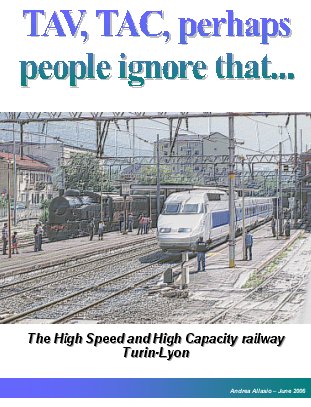 You
can access contents clicking on the links
below
You
can access contents clicking on the links
below  You
can access contents clicking on the links
below
You
can access contents clicking on the links
below
by Andrea Allasio - June 2006
Content
1.st
Part
1. INRODUCTION 3
1.1. History and status of the Turin-Lyon
1.2. Geographical framework
2.nd
Part
2. THE HIGH SPEED RAIWAY LINE TURIN-LYON 7
2.1. Main data and a bit of clarification concerning the tunnels.
2.2. The historical line Turin-Modane
2.3. The connections of the new High Speed line with the historical line
2.4. Traffic model of the Turin-Lyon
3.rd
Part
2.5. Leaving Turin …..
2.6. The transportation of the passengers
2.7. The freight transportation
4.th
Part
2.8. Is the freight transportation by road really increasing?
2.9. The construction sites in the Italian territory
2.10. The tunnel extracted material, utilisation, transportation and disposal.
5.th
Part
2.11. The costs
2.12. Who is financing the Turin- Lyon ?
2.13. The operative costs
2.14. The Turin-Lyon work planning
2.15. What about France ?
2.16. The Europen Comunity and the High Speed Railway projects
2.17. Benefits and comfort for the Susa Valley residents
6.th
Part
3. AMBIENT IMPACTS AND IMPLICATIONS
3.1. Is there asbestos or not ?
3.2. About uranium
3.3. Powders, particulate, other polluting elements and their transportation
3.4. The acoustic noise
3.5. The effects on the human health
3.6. Hydrological risks
3.7. Impact on residential, industrial and agriculture areas
3.8. Archaeological impacts
7.th
Part
4. THE ALTERNATE PROPOSAL TO THE TURIN-LYON
4.1. The enhancement of the historical line (not to be confused with the CIPE
approved)
4.2. Improvement of other lines
4.3. The results of the proposal
5. THE REASONS OF THE OPPOSITION
6. REFERENCES
-------------------------------------------------------------------------------
Preface
In December 2005, the facts and protests against the TAV (in Italy this stands
for High Speed Train) in the Susa Valley have finally highlighted at national
level the problematic over the Turin-Lyon and the concerns of the population.
Events were reported with different cuts, depths and perspectives, but the framework
and the information concerning this railway project, which apparently is one
the most sponsored in Europe, were passed in general very superficially and
most of the time biased.
There is no need to go too far from Susa Valley for understanding the lack of
information concerning the project, talking with people leaving in Turin is
more than enough. More then a person found is in favour of the railway because
gives the opportunity to reach the ski field in about half an hour from Turin
or because it allows to go to Paris in few hours, not knowing that the line
passes 600 meters under the ground level, not in the centre of the valley and
the saving over a long trip as Turin to Paris is just an hour. Someone talks
about the freight transportation, however nobody has the idea of the volume
of the freight being transported, the future forecast, the other railway lines
and tunnels under construction around the Alps and finally, if the project is
really mandatory or not.
Alarming is the scenario of so many people found totally unaware of the project
and the consequences to be paid in terms of health, taxes and drawbacks of various
nature, in favour of the advertised advantages that the new railway line will
never be able to produce.
Anyone who wants to know the project, its context, building an own idea, can
found in this paper a synthesis of technical data and information taken from
official documentation of the project, studies conducted by Universities and
independent institutions, report and publications of the European Community,
of the “Corte dei Conti”, minute of meetings of the Technical Commission,
as well as publications from Italian, regional, provincial and local administrations,
newspapers and so on.
Most of these data are available on the official internet sites of the Piedmont
Region, Transpadania, Transalpine, LTF and together with the official documentation
of the project design constitute a knowledge base available to the Susa valley
concerned inhabitants.